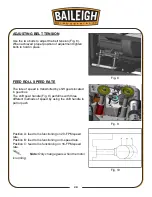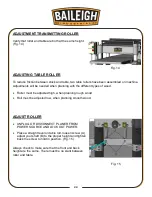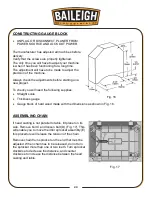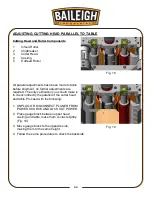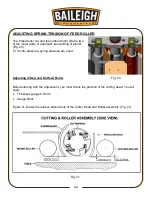
12
12
TRANSPORTING AND LIFTING
Follow these guidelines when lifting with truck or trolley:
•
The lift truck must be able to lift at least 1.5 – 2 times
the machines gross weight.
•
Make sure the machine is balanced. While
transporting, avoid rough or jerky motion, and maintain
a safe clearance zone around the transport area.
•
Use a fork lift with sufficient lifting capacity and forks
that are long enough to reach the complete width of
the machine.
•
Remove the securing bolts that attach the machine to
the pallet.
•
Approaching the machine from the side, lift the machine on the frame taking care that there
are no cables or pipes in the area of the forks.
•
Move the machine to the required position and lower gently to the floor.
•
Level the machine so that all the supporting feet are taking the weight of the machine and no
rocking is taking place.
INSTALLATION
IMPORTANT:
Consider the following when looking for a suitable location to place the machine:
•
Overall weight of the machine.
•
Weight of material being processed.
•
Sizes of material to be processed through the machine.
•
Space needed for auxiliary stands, work tables, or other machinery.
•
Clearance from walls and other obstacles.
NOTICE: Lifting and carrying operations should be carried out by skilled workers, such as a
truck operator, crane operator, etc. If a crane is used to lift the machine, attach the lifting
chain carefully, making sure the machine is well balanced.
WARNING:
FOR YOUR OWN SAFETY, DO NOT CONNECT THE MACHINE
TO THE POWER SOURCE UNTIL THE MACHINE IS COMPLETELY ASSEMBLED AND
YOU READ AND UNDERSTAND THE ENTIRE INSTRUCTION MANUAL.
Summary of Contents for IP-156
Page 20: ...18 18 ELECTRICAL DIAGRAM...
Page 33: ...31 31 PARTS DIAGRAM SHEET 1 To Parts Sheet 2...
Page 34: ...32 32 PARTS DIAGRAM SHEET 2 From Parts Sheet 1...
Page 35: ...33 33 PARTS DIAGRAM SHEET 3...
Page 36: ...34 34 PARTS DIAGRAM SHEET 4...
Page 43: ...41 41 NOTES...






















